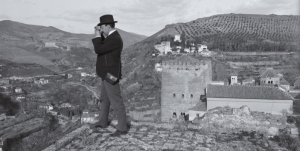10 minutes walking from The Alhambra Palace Hotel
On the 150th Anniversaryof the Alhambra as Cultural Heritage
February 14 to May 24, 2019
Monumental Complex of the Alhambra and Generalife. Palace of Charles V. Chapell
Free admission. Reservations: alhambraeduca.pag@juntadeandalucia.es
Winter opening hours
From October 15 to March 14. Monday through Sunday, 10 a.m. to 6 p.m.
Summer opening hours
From March 15 to October 14. Monday through Sunday, 10 a.m. to 8 p.m.
In autumn 1868, as a result of the “glorious revolution”, the Alhambra was seized from the Crown and ceased to be a royal palace to become property of the State. In appearance, nothing changed after this rapid and irreversible change in ownership. However, the Nasrid palace and its surroundings began a new uncertain phase which was to consolidate them as a historic emblem to be officially conserved, an increasingly important resource for culture and tourism, and an asset which was complicated to manage, as it had to take on the intrinsic functions of a cultural asset in the public domain.
In the following decades, the institutional transformation required to overcome these challenges coincided with the wave of innovations characteristic of the second Technological Revolution, which were affecting many sectors of activity in Restoration Spain and especially its monuments.
The adoption of many of these technological solutions and the business initiatives arising from monuments were determining factors in the transformations in the Alhambra, similar to those of the contemporary urban landscape. Basic service networks (gas, electric lighting, water supply, telephone) were installed; new spaces appeared for communication and socialisation, found in the public promenades and the cultural events and celebrations in Plaza de los Aljibes or the Palace of Carlos V; new transport solutions such as trams and the adaptation to road traffic were proposed; neighbouring spaces were converted to accommodate new private residential uses (cármenes) as well as services linked to tourism (boarding houses and hotels, shops, photography studios); and finally, new techniques and materials were incorporated into the on-going restoration and conservation work, while other innovations in graphic communication projected the image of the monument which was already universal heritage more efficiently.
Monumentalization and Modernisation are key in bringing people closer to the contemporary Alhambra shaped between the 19th and 20th centuries. The proposal for this exhibition —structured as a journey through time starting in 1868 and ending provisionally around 1936— shows the transformations required by its new functions as a monumental territory and resource for the city itself. The festive and cultural use of some of its spaces ran parallel to the process of monumentalization: the concerts organised from 1883 in the Palace of Carlos V, the outdoor parties and shows in Plaza de los Aljibes or the lighting of the promenades for Corpus Christi celebrations began a tradition which was further strengthened in later decades. At the same time, the public perimeter was consolidated and expanded, while a large part of the hill remained privately owned, acquiring new value due to its proximity to the Alhambra.
This area was made up of different properties which saw changes in ownership and use following the new residential habits of the wealthy classes and the business opportunities provided by tourism.
Today, coinciding with the 150th anniversary of the start of these transformations it seems timely to take a closer look at this particular symbiosis between monumentalization and modernity which is a feature of the Alhambra’s contemporary evolution. A route is proposed through three major areas: the monument, technological innovations, and the initial impact of tourism. Taking the monument as a substratum and tourism as the most characteristic expression of a new era, the main discourse of this exhibition focuses on the technological dimension of modernity. Hence more attention is paid to some of the Alhambra’s characteristic settings and chapters, showing different objects, documents and images grouped into six major sections: the innovations adopted to guarantee the integrity of the monument in the event of lightning, fire or theft; the use of gas and electric artificial lighting; the new systems of water installations and use; the design and construction of new transport accesses and systems which materialized with the arrival of the electric tram in 1907; the use of new materials such as iron and concrete in the conservation of the monument; and finally, an examination of all the advances in graphic representation (planimetry, lithography, photography, cinema) which greatly boosted the projection of the image of the Alhambra. Extensive research has been carried out to date the appearance of these innovations, examining the controversies they sparked off and how they integrated into the landscape and the image of the monument.
More info:
http://www.alhambra-patronato.es/index.php/Home/1472+M5d637b1e38d/0/
https://www.ideal.es/culturas/anos-fascinacion-alhambra-20190215213707-nt.html

Deja una respuesta